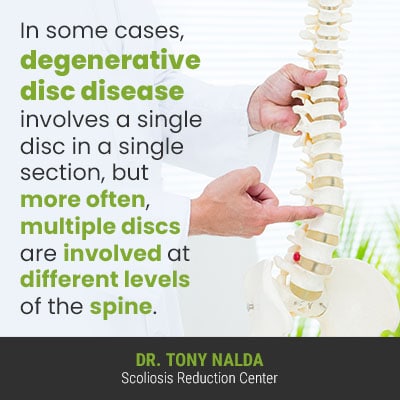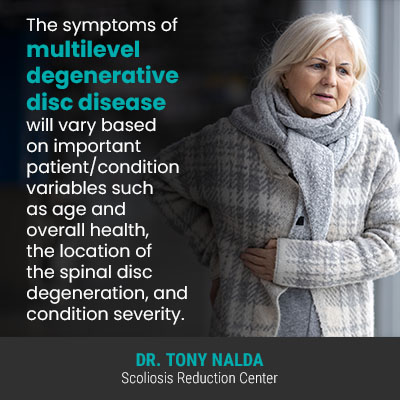In order for the spine to function optimally, it has to maintain its natural curvatures and alignment, and the spinal column, including the spinal discs, is an important part of the spine’s overall health and function. The intervertebral discs are often the first spinal structures to deteriorate. Degenerative disc disease can involve a single disc in a single spinal section, or involve multiple sections of the spine: multilevel degenerative disc disease.
The vertebrae (bones of the spine) are stacked on top of one another and separated by intervertebral discs. Degenerative disc disease develops as the intervertebral discs experience degenerative changes; when this occurs at multiple levels of the spine, this is multilevel degenerative disc disease.
Let’s start our discussion of multilevel degenerative disc disease by first taking a look at some basic spinal anatomy.
Anatomy of the Spine: Intervertebral Discs
A healthy spine appears straight when viewed from the front and/or back and takes on a soft ‘S’ shape when viewed from the sides; this is due to the spine’s natural and healthy curves that make it stronger, more flexible, and better able to absorb and distribute mechanical stress.
In order for the spine to function optimally, these natural curves have to be maintained, and the spinal disks are an integral part of that.
The vertebrae (bones of the spine) are rectangular in shape and stacked on top of one another in a straight and neutral alignment; the vertebrae are separated by intervertebral discs.
The discs are made up of a tough outer layer (annulus) and a soft gel-like interior (nucleus).
The discs consist of water, collagen fibers, and proteoglycans, and the durable outer annulus facilitates the spine’s rotational stability and helps counteract compression.
The annulus and nucleus work together to distribute weight and stress from one vertebral body to another.
As mentioned, the discs are generally the first spinal structures to experience degenerative changes, and an important characteristic of the spinal discs is that they are the largest structures of the body to not have their own vascular supply; this means there is no direct path into, and out of, the discs for the transport/absorption of important nutrients needed for cellular repair.
Through a series of osmotic processes, the discs can absorb nutrients needed from their surroundings, which is why movement is so important because it increases hydration/circulation around the spine, making these nutrients more available for the discs to absorb.
Once one or more spinal discs have started to deteriorate, it’s difficult to reverse these changes, which is why degenerative disc disease is so prevalent in aging adults.
So now that we have discussed some basic spinal anatomy, including the structure and function of the discs, let’s move on to the causes of multilevel degenerative disc disease.
Understanding Degenerative Disc Disease
Degenerative disc disease is a common condition that affects millions of people worldwide. It is a degenerative process that occurs in the discs of the spine, leading to pain, discomfort, and reduced mobility.
The condition is characterized by the breakdown of the spinal discs, which are the soft, gel-like structures that separate the vertebrae in the spine. As the discs degenerate, they lose their ability to cushion the spine, leading to pain and stiffness.
Degenerative disc disease can occur in any part of the spine, but it is most common in the lumbar spine (lower back) and cervical spine (neck). The condition is often associated with aging, but it can also be caused by injury, genetics, and lifestyle factors. The spinal discs play a crucial role in maintaining the spine’s flexibility and absorbing shock, so their degeneration can significantly impact overall spinal health.
There are three main sections of the spine: cervical (neck), thoracic (middle/upper back), and lumbar (lower back).

In some cases, degenerative disc disease involves a single disc in a single section, but more often, multiple discs are involved at different levels of the spine.
While there is a certain degree of spinal degeneration expected with age, other factors that can increase degenerative changes include leading a sedentary lifestyle, carrying excess weight, chronic poor posture, excessive alcohol consumption, and repeatedly lifting heavy objects incorrectly and straining the spine.
Multilevel degenerative disc disease is a common spinal condition for adults 40+ years of age, and natural age-related degenerative changes are the most common cause of multilevel degenerative disc disease.
Advanced degenerative disc disease can lead to symptoms like nerve root compression and spinal canal narrowing, emphasizing the importance of understanding its progression and implementing effective management strategies.
Multilevel degenerative disc disease encompasses various spinal conditions, including C5-C6 disc bulging and levoconvex scoliosis, indicating the involvement of multiple levels of the spine in the degenerative process.
The symptoms of multilevel degenerative disc disease will vary based on important patient/condition variables such as age and overall health, the location of the spinal disc degeneration, and condition severity.
Multilevel degenerative disc disease, characterized by the gradual breakdown of intervertebral discs, differs from conditions like spondylolisthesis and the comparison between scoliosis and spondylosis elucidates the distinct nature of spinal disorders.
Some patients with mild multilevel degenerative disc disease don’t experience noticeable symptoms at all, until affected discs degenerate to the point where they lose shape, become desiccated, and nearby spinal nerves become compressed/impinged as a result.
Multilevel degenerative disc disease refers to the progressive condition characterized by multi-level degenerative disc disease, which entails multilevel disc space narrowing and disc space loss due to intervertebral disc degeneration, as observed on magnetic resonance imaging. This degeneration affects the intervertebral discs and vertebral endplates, contributing to spinal instability and potential discomfort.
Multilevel degenerative disc disease (DDD), indicated by multilevel disc bulging and classified under ICD-10 codes for various regions such as DDD LS spine, thoracic, and cervicothoracic disc disorders, involves degenerative changes in intervertebral discs, affecting the lumbar, sacral, sacrococcygeal, and thoracic regions, with the prognosis depending on the extent of the degeneration and associated disorders like other intervertebral disc degeneration.
Multilevel degenerative disc disease refers to the presence of multifocal degenerative changes, including disc and facet degeneration, in the thoracic spine, characterized by herniated discs, bone spurs, and spinal cord compression, often necessitating surgical intervention to address symptoms and define the extent of degenerative changes.
When there is a degree of nerve involvement, symptoms can include:
- Localized back pain
- Radicular pain felt anywhere along a compressed nerve’s pathway
- Numbness/tingling
- Changes to gait (particularly when the lumbar spine is involved)
- Muscle weakness
So if a diagnosis of multilevel degenerative disc disease is given, how is it treated?
Multilevel Degenerative Disc Disease Treatment
As mentioned, once the discs of the spine start to deteriorate, the process of reversing damage is limited and lengthy, so prevention is important.
Preventing degenerative disk disease involves adopting proactive treatment approaches, including lifestyle modifications and specific therapeutic interventions.
Multilevel degenerative disc disease, also known as advanced multilevel degenerative disc disease, is a condition characterized by widespread degeneration of the intervertebral discs in the cervical spine, leading to multilevel spondylosis and related changes. In severe cases of degenerative disk disease, individuals may require surgical intervention like spinal fusion to alleviate their symptoms and improve spinal stability.
While a certain degree of spinal degeneration is expected with age, lifestyle factors can increase, or decrease, these effects over time.
Maintaining a healthy weight is important because it means the joints of the spine don’t have excess weight to support, exposing them to constant strain.
Maintaining a healthy activity level is key as the very design of the spine is based on movement, and it’s through movement that the discs of the spine can maintain their fluid levels and absorb needed nutrients from their surroundings.
Chronic poor posture can be corrected so the spine is not exposed to adverse spinal tension that, over time, can lead to increased spinal degeneration.
Alcohol consumption and smoking are also negative lifestyle choices that, over time, can decrease the body’s fluid levels and contribute to disc desiccation (excessive fluid loss).
For those with jobs that involve repeatedly lifting heavy objects, doing so incorrectly exposes the spine to excess strain, uneven distribution of mechanical stress, and puts the spine at risk of injury.
Multilevel degenerative disc disease, as classified by ICD-10, refers to the condition where osseous structures exhibit degenerative changes across multiple levels of the lumbar spine, commonly affecting discs such as L3-L4, highlighting the widespread nature of lumbar disc degeneration in lumbar degenerative disc disease.
Multilevel Degenerative Disc Disease involves degenerative changes at multiple spinal levels, such as cervical disc degeneration and lumbar DJD (ICD-10), raising questions like ‘is endplate sclerosis a disability,’ and encompasses various cervical disc disorders classified under codes like cervical DJD ICD-10, cervical disc degeneration, other cervical disc degeneration, and unspecified cervical region.
While keeping these factors in mind, leading a spine-friendly lifestyle can decrease spinal degeneration and keep the spine as healthy, strong, and flexible for as long as possible.
For those already diagnosed with multilevel degenerative disc disease, there are a number of treatment options available, and here at the Scoliosis Reduction Center®, I specialize in nonsurgical treatment for a variety of spinal conditions, multilevel degenerative disc disease included.

Once the underlying cause of the disc degeneration is determined, a customized treatment plan can be crafted.
While disc damage can’t be fully reversed, a certain degree of disc function can be restored, but just as the process of disc degeneration takes place slowly over years, the process of restoration is also lengthy.
Through a conservative chiropractic-centered treatment approach, I can customize effective treatment plans with the goal of restoring disc function, preventing further damage, and increasing core strength so the spinal muscles can optimally support the spine.
Through condition-specific chiropractic care, I can use a variety of techniques, such as gentle manual adjustments, to alter the position of adjacent vertebrae, which affects the shape and height of the disc in between.
Through physical therapy and condition-specific exercises/stretches, I can increase core strength so the spine is optimally supported and stabilized by its surrounding muscles, taking pressure off the discs, circulation is improved, and the spine, and its surroundings, are kept as strong, loose, and flexible as possible.
In addition, lifestyle guidance is another component of treatment here at the Center, as diet and exercise can have a big impact on the spine’s overall health and function.
While these disciplines are unlikely to fully reverse all disc degeneration in all spinal sections, they can go a long way in terms of restrengthening and restabilizing the spine, while preventing further disc bulging or breakdown.
The spine is a complex structure that provides the body with stability, enables flexible movement, and helps to absorb/distribute stress from impact and movement.
In addition, the spine works in tandem with the brain to form the body’s central nervous system (CNS), which is why spinal conditions can cause a myriad of symptoms felt throughout the body.
The bones of the spine are separated by intervertebral discs, and these discs are tough and durable on the outside, and soft and malleable on the inside.
The discs combine forces to facilitate range of motion, provide the spine with structure as adjacent vertebrae attach to the disc in between, provide cushioning between adjacent vertebrae to prevent friction during movement, and act as the spine’s shock absorbers.
With the above roles in mind, it’s clear how important the spine’s discs are in maintaining overall spinal health and function.
Once a disc starts to degenerate and cause symptoms, this is known as degenerative disc disease, and if multiple discs are deteriorating in different spinal sections, this is known as multilevel degenerative disc disease.
The most common cause of multilevel degenerative disc disease is natural age-related spinal degeneration, and the cumulative effect of negative lifestyle choices can also play a role, in addition to the presence of other spinal conditions.
When it comes to the treatment of multilevel degenerative disc disease, here at the Scoliosis Reduction Center®, treatment plans are guided by the condition’s underlying cause and integrate multiple different forms of treatment for the best results.
Symptoms and Diagnosis
The symptoms of degenerative disc disease can vary depending on the location and severity of the condition. Common symptoms include:
- Back pain or neck pain that worsens with movement
- Pain that radiates to the arms or legs
- Numbness or tingling in the arms or legs
- Weakness in the muscles
- Reduced range of motion
To diagnose degenerative disc disease, a doctor will typically perform a physical examination and review the patient’s medical history. Imaging tests such as X-rays, CT scans, or MRI scans may also be ordered to confirm the diagnosis. These tests help visualize the extent of disc degeneration and identify any associated issues, such as herniated discs or spinal nerve compression.
Treatment Options
Treatment for degenerative disc disease depends on the severity of the condition and the patient’s overall health. Conservative treatment options include:
- Physical therapy to strengthen the muscles and improve flexibility
- Pain relief medication to manage pain and inflammation
- Lifestyle modifications such as maintaining a healthy weight, quitting smoking, and improving posture
In some cases, surgery may be necessary to relieve pressure on the spinal nerves or to stabilize the spine. Surgical options include:
- Spinal fusion to join two or more vertebrae together
- Disc replacement to replace the damaged disc with an artificial one
- Discectomy to remove the damaged disc
These treatments aim to alleviate pain, improve function, and prevent further degeneration of the spinal discs.
Managing the Condition
Managing degenerative disc disease requires a comprehensive approach that includes lifestyle modifications, physical therapy, and pain management. Here are some tips for managing the condition:
- Maintain a healthy weight to reduce the strain on the spine
- Engage in regular exercise to strengthen the muscles and improve flexibility
- Improve posture to reduce the workload on the spine
- Avoid heavy lifting and bending
- Get enough sleep to help the body recover from the day’s activities
By incorporating these strategies into daily life, individuals can help manage their symptoms and maintain a better quality of life despite the condition.
Advanced Treatment Approaches
In recent years, advanced treatment approaches have been developed to treat degenerative disc disease. These include:
- Stem cell therapy to promote the growth of new disc tissue
- Platelet-rich plasma (PRP) therapy to stimulate healing
- Minimally invasive surgical procedures to reduce recovery time and scarring
These advanced treatment approaches are typically used in conjunction with conservative treatment options and are usually recommended for patients who have not responded to traditional treatment. They offer new hope for those suffering from degenerative disc disease, aiming to restore disc function and alleviate pain more effectively.
Reversing Degenerative Disc Disease
While it’s challenging to completely reverse degenerative disc disease (DDD), especially in advanced cases, a proactive approach targeting the underlying causes can lead to improved outcomes. Instead of merely managing symptoms like pain, addressing the root cause—such as spinal misalignment—is key to potentially reversing some of the damage. By correcting spinal alignment through chiropractic care and targeted physical therapy, the pressure on affected discs can be reduced, allowing for some disc regeneration and slowing further degeneration.
This approach is particularly useful when degenerative disc disease is caused by conditions like scoliosis. With scoliosis, the spine’s curvature accelerates disc degeneration, but by reducing the curve and improving spinal alignment, the discs may regain some functionality.





